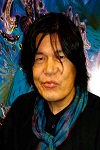
Biography
Biography: Yoichiro Kawaguchi
Abstract
I would like to reflect on computer graphic and multi-media arts from the vantage point of my own 40 years of association with them. First of all, a person must seek out the creative things he or she is aiming for from a point removed from principle-like habits and the tendencies of soft-ware programs created in advance. Namely, I think it is important that a person does not let his or her own creative urge get covered by a program with rather technical things pushed into the foreground. Independence and originality concerning form and color have no meaning unless completely controlled by the person who stands at the core of art. One should never create a structure embodying something developed through easy, wild numbers and chance. Moreover, there is a method of creating living things and/or nature under a quasi-reconstruction of the laws of the natural world. This method, which approaches the observation values as closely as possible, will continue for a long time hence. This is to pursue why materialistic shapes and colors exist in this transcendent sphere which include the natural world and the cosmos. The enlargement of those realms of existence will certainly render a moulding cut off from the framework of earth or mankind possible. This will come to question its main constituent in the very process of selecting various subjects. Consequently, the way of existence of the object itself is already a product of conception, which is not cut off at all from the artistic qualities from which it should be separate. The very laws themselves concerning form have arisen and grown, creating their own present system which is self-propagating. In other words, the process has hypothesized something which retains energy within. It is something which has advanced one step beyond a simulation of a cross-section of the natural world. It is an approach to nature in another sense. That is to say, because circumstantial stimulation can called a hypothesis thin the framework of fixed time, it becomes equipped with the same time as the observer despite the lack of a non-present system of simultaneity. Thus, the immediacy and the extemporaneousness of formation come to have direct perceptions and connections. My “Growth” series lies indeed at the starting point. Demands will be made from now on in the form of self-propagation and natural occurrence, and they appear to have active bearings on the sixth sense in human beings and aesthetics.

